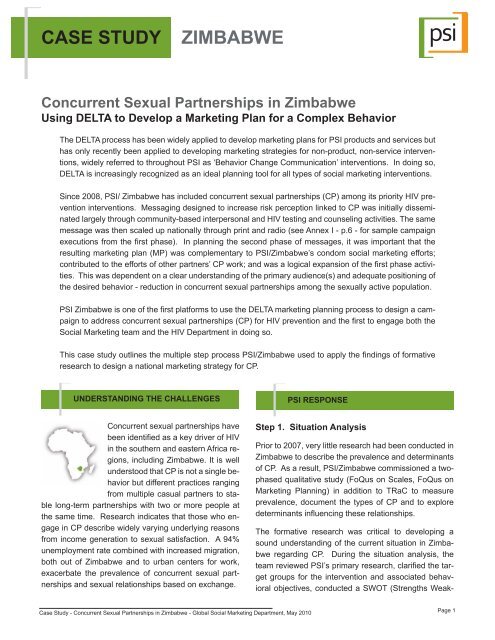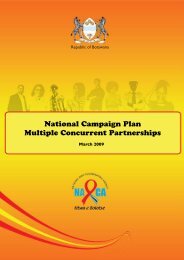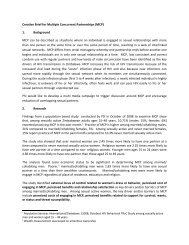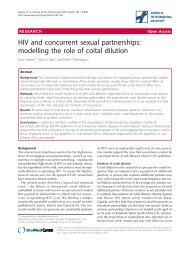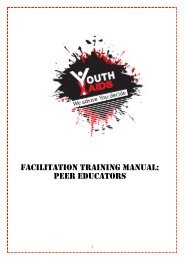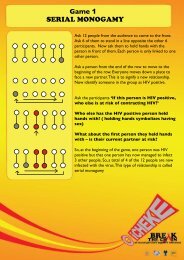case study zimbabwe - CONCURRENT SEXUAL PARTNERSHIPS ...
case study zimbabwe - CONCURRENT SEXUAL PARTNERSHIPS ...
case study zimbabwe - CONCURRENT SEXUAL PARTNERSHIPS ...
- No tags were found...
You also want an ePaper? Increase the reach of your titles
YUMPU automatically turns print PDFs into web optimized ePapers that Google loves.
dence gained by earning what you have through yourown skills and efforts:threat drove condom use, but rarely resulted in a reductionof partners.FemaleTargetFrame of ReferenceFor Fadzi, not having concurrent partners showsreal independence and focus, earning herrespect and admiration from her friendsand family.Emotional PoDAs a result, the selected objectives were:Men:Significantly increase the mean score of‘perceived cost’: failure to achieve goals;loss of social status and resources amongmarried men aged 25-39 by March 2011Women 1: Significantly increase the mean score of‘perceived cost’: failure to achieve goalsamong urban sexually active women aged16-24 by March 2011For Munya and Gibson, concurrent partnerships givethem variety, confidence and status among their peers.However, many men feared their wives discovering theirextra-marital relationships and identified the monetaryexpenditures necessary to maintain these relationshipsas a major cost. Munya and Gibson’s aspirations centeredon earning money and providing for their families.Put together, it became obvious that Munya andGibson’s ambitions would be better realized if they werenot spending their money on women, making them moresuccessful at work, a better provider, and for those reasons(instead of womanizing) admired by their peers.This insight formed the basis of the positioning for Munyaand Gibson:MaleFor Munya and Gibson, not having concurrentsexual partnerships helps them realize theirambitions without fear, improving their relationshipat home and status among theirpeers.Women 2: Significantly increase the mean score of‘perceived benefits’: wants among urbansexually active women aged 16-24 byMarch 2011Recognizing that a complex behavior like concurrent sexualpartnerships is often reinforced and/or discouragedthrough complex social norms and influencers, the teamreviewed how they might invoke a simultaneous advocacystrategy to influence the national dialogue aroundCP or encourage national and local opinion leaders tomake public statements countering CP. These effortswill require specific audience segmentation, communicationobjectives and key messages for these ‘secondary’or influencing audiences, which is reliant on additionalresearch. Hence, the group decided to consider this ata later stage. However, the first promotion P messageutilizes peer persuasion, as their direct influence on socialand sexual decision making is too strong to ignore.Messages developed under the promotion P would reinforcethese statements.Step 4: Set ObjectivesMany factors influenced the choice of output level indicatorsbut ultimately perceived cost was chosen for bothaudiences and perceived benefits for targeted women.Because ‘perceived threat’ was already being addressedin the Phase 1 , it was not chosen as an objective foreither audience. Additionally, research revealed thatCase Study - Concurrent Sexual Partnerships in Zimbabwe - Global Social Marketing Department, May 2010Page 3
Step 5: Developing Plans for the Four PsAs the positioning demonstrated,the “product”, or what we were tryingto sell to the target groups, wasthe desired behavior: avoiding CP.Unlike many social marketing interventions,this intervention doesnot have an obvious tangible product(in the commercial sense of theword) associated with it. That doesnot mean, however, that the four Psdo not apply.PRODUCT P: The absence of anobvious or essential product for thisintervention did not mean that thestrategy could not support the behaviorwith something tangible (referredto in the DELTA process as a“supporting product”). In this <strong>case</strong>,The PSI/Zimbabwe staff came up with two ideas for supportingproducts – things that would be promoted in theirown right, but would also support the desired behavior.One was a call-in radio show called “Dr. Love” that wouldoffer relationship advice – this would be geared towardsimproving communication and intimacy in relationships.The lack thereof was identified as one driver of concurrencyin the FoQus research. In sum, this brandedformat would be designed to help the audience identifyways to improve their current relationship and ‘lack ofintimacy’ as opposed to merely disseminating messagesabout the risks of CP.A second potential supporting product identified was afemale-oriented lecture series. This would target youngwomen and present tips and stories from successfulwomen in the community. The main objective of thesesessions would be to demonstrate to young women thatsuccess is a result of personal drive and effort, not boughtwith someone else’s money. The latter point could besubtly reinforced by the speakers chosen through carefulrecruitment and briefing of the speakers in advanceof each lecture.For the 1-year period of the marketing plan, PSI/Zim staffchose to try out only the lecture series. In the interim,the team agreed to conduct further research about theimplications and context of ‘relationship satisfaction’ as adriver of CP and gain a better understanding of UNFPA’swork on the same topic. Upon doing so, the radio pro-gram may be piloted in 2011.PRICE P: The costs of practicingor avoiding CP (both monetary andsocial) were discussed at lengththroughout the planning process.As mentioned earlier, the researchindicated that many rural womenengaged in CP for their basic survival.The cost to them for avoidingCP – not being able to meet theirbasic subsistence needs- was notsomething PSI could address. Themonetary cost of CP relationshipsfor men was an important deterrentto behavior and thus it was includedas an aspect of a promotion P message.Non-monetary costs, includingthe loss of self-respect for womenand loss of social status for men,also informed both the positioningand promotion P decisions.PLACE P : In the context of the intervention, place P decisionswere made based on epidemiological and behavioralfactors; locations where there would be both moreCP and higher HIV prevalence. Thus seven urban areaswere identified as intervention sites in addition to highriskrural locations such as rural business centers, miningareas, and farming settlements within four provincesthat have the highest rates of HIV in the country.PROMO P: PSI/Zim staff used the available researchabout Fadzi, Munya and Gibson to identify the most appropriatecommunication channels. The chosen channelswere considered for their ability to maximize reach,cost per person reached and format appropriateness foreach of the behavioral determinants. The DELTA processhelped synthesize several key issues that influencedthe Promo P, specifically, the fact that CP is widelyprevalent and rarely discussed, the importance of socialinfluences, and the cost incurred by engaging in CP. Inorder to address this, radio was chosen as the unifying(anchor) media supplemented by outdoor and roadshows in rural areas, and print, small group discussionsand IPC in urban areas.The pervasive nature of CP among men in Zimbabweanculture, along with its tacit acceptance among men (andmany women), led to the realization that the anchor radiocampaign could not be a subtle one. Generating discus-© Population Services International - Global Social Marketing Department, May 2010Page 4
sion would only happen if PSI/Zim “dropped a bomb” inthe form of a powerful and potentially controversial radiocampaign. Stimulating ongoing discussion or ‘buzz’would be reliant on more participatory interpersonalcommunication that would allow target audiences tothink critically about their behavior and challenge socialnorms.One of the behavioral determinants for the men was fearof loss of social status. There would be no way to influencemen’s perceived status as a result of having concurrentpartners without changing how their peers reactto the behavior. Therefore, to target Munya and Gibson,there needed to be a change in their social environmentthat not only made avoidance of CP acceptable, but worthyof approval. However, men currently feel it’s not theirbusiness to vocally disapprove of CP. Thus, the messagebuilds on heightened risk perception from phaseone to encourage social disapproval of CP:C BenefitKEY MESSAGEThere’s no pride in risking one’s future. Makeit your business to discourage overlapping sexpartners among your peers.Call to ActionUThe initial message to women, while not as controversial,would also seek to play on their sense of self-respect inline with the positioning:Lessons Learned• DELTA is a practical and useful tool for social marketingplanning even with interventions that haveno readily apparent service or tangible product.• Each of the 4 P’s is relevant to non product/nonservice marketing plans.• Special considerations should be made to considerall elements of the Price P including non-monetarycosts incurred by the target audience throughmaintaining or changing behavior.• The Product P includes both the desired behaviorand any ‘supporting’ products. For CP, Zimbabwechose supporting products which aim to create amore conducive environment for behavior changethrough modeling and increasing social support.• Because of the nature of this intervention, and thereliance on social norms, research should includeperspectives from both the primary audience andthose who may influence the primary audience’sbehavior.For more information about how toapply DELTA to effective social marketinginterventions, contact:jennifer@sfh.co.zadsherard@psi.orgSocial Marketing Planning for Health ImpactKEY MESSAGELuxuries come at a cost. They’re not worth myself- respect and independence. I choose notto have more than one partner at the sametime.Messages on other determinants would follow in 3 monthrotations (see message delivery plan in annex 3).PSI is a leading global health organization with programs targeting malaria, childsurvival, HIV and reproductive health. Working in partnership within the publicand private sectors, and harnessing the power of markets, PSI provides lifesavingproducts, clinical services and behavior change communications thatempower the world’s most vulnerable populations to lead healthier lives.www.psi.orgCase Study - Concurrent Sexual Partnerships in Zimbabwe - Global Social Marketing Department, May 2010Page 5
Annex 1Print materials from the first phase of Zimbabwe’s campaign included messaging designed to increase risk perception(perceived threat) among men and women engaging in concurrent sexual partnerships.Poster 1Targets men whohave concurrent sexualpartners and who maynot know about their‘small house’s’ sexualbehaviorPoster 2Targets women whoare the sexual partnerof men who have other,overlapping sexualpartners© Population Services International - Global Social Marketing Department, May 2010 Page 6
Annex IIAUDIENCE SUMMARIESMarried and/or cohabiting urban manMunya is 35 years old, married with two children. He values his children and aspires to send them to betterschools. He lives in a low income suburb and runs a small business fixing cars. He owns a modest carand aspires to buy a better car to improve his ‘status’ especially among his friends. He also aspires to owna home in one of the affluent low density suburbs. Munya’s life is very busy, as running his own small businessis demanding. He finds his sex life boring and seeks extra marital partners to meet his sexual needs.Munya has two ‘small houses’ Nancy and Rutendo. Nancy has been Munya’s ‘small house’ for about 5 yearsand she really understands him. Rutendo is beautiful and fun to be around. He normally sees both of themevery day. Munya does not use condoms with Nancy as he ‘trusts’ her though he uses them inconsistentlywith Rutendo. Munya occasionally spends time with his drinking buddies, watches television and listens tothe radio. He occasionally worries that maintaining small houses is expensive, but at the same time thinksthe girls are worth it.Married and/or cohabiting rural manGibson is a 32 year old married man living in the rural areas. He has three children and also looks after hisbrother’s children. He runs a butchery at a rural business centre in Mhondoro. He spends most of his timeat the bottle store, drinking beer with friends and relatives. Gibson has several girlfriends and occasionallysleeps away from home and his grandmother covers up for him. He trusts his “small house” Ropa and his“sweet sixteen” Rachie and does not use condoms with them as he believes he is the only man in their lives.He uses condoms with Audrey and Nyasha and other casual girlfriends because he worries about the risk ofHIV infection. He wants to succeed in life and provide well for his family. Gibson hopes to expand his businessand looks forward to a healthy life. His sex life at home is boring and he spices it up by having extramarital affairs though he is worried about being discovered by his wife and mother. He listens to the radio andreads the newspaper whenever he gets access to one.Single never married womanFadzi is in her early 20s, single and a college student. She lives in a one room rented accommodation. Shelikes to party, braai, dance and drink at places such as outdoor entertainment spots that include Mereki,Globe Trotter, Car Wash and IBs. She loves having the 3 C’s (cash, car and cell phone) and other luxuries.She has several friends that she hangs out with and confides in her closest friend, Mona. She has severalpartners and uses condoms with some of them because she does not trust them. She is more worried aboutpregnancy and the disappointment and embarrassment to herself and her family. Fadzi does not believethat being involved in overlapping sexual relationship will prevent her from realizing her full ambition of beinga graduate, running her own business and getting married. She believes that having more than one sexualpartner at the same time makes her more popular among her peers.© Population Services International - Global Social Marketing Department, May 2010 Page 7
Annex IIIMEDIA DELIVERY PLANMessages1. Show you can make it in life on your own. Realize your potential by choosing not to have more than one sexualpartner at the same time.2. Luxuries come at a cost. They’re not worth my self- respect and independence. I choose not to have more thanone partner at the same time.3. There’s no pride in risking one’s future. Make it your business to discourage partners among your peers.4. A clever man invests his resources where he gets good returns, at home and work, not down the drain. Choosenot to have overlapping sexual partners.Channel Location 2010 2011 NotesAprilMayJuneJulyAugustSeptemberOctoberNovemberDecemberJanuaryFebruaryMarchRadio(spots, call-in, DJs)NewspaperOutdoor(Billboard, wallpaintings, posters,bus and oxcartstickers)Small group discussionRoad showsLecture SeriesWorkplace IPCNational2 & 3 1 & 4 2 & 3 1 & 46 papers includingWeekly Press 3 a 3 b 4 a 4 b 3 b 4 b a. Once per weekb. Two times per monthManicaland,Harare, MatabelelandSouth,MashonalandEastvocationalschoolsManicaland, MatabelelandSouth,MashonalandEastHarare, Bulawayo,Gweru,Masvingo, Mutare,Chinhoyi,BinduraHarare, Bulawayo,Gweru,Masvingo, Mutare,Chinhoyi,Bindura2 & 3 1 & 4 2 & 3 1 & 42 1 2 13 4 3 414 3 4Includes peri-urban andrural areas in these provinces.Each urban location listedwill host a lecture twice inthe course of the year.NoteTV is not included now - the decision to use or not use TV in this campaign will be determined after the measurement of the Phase I media campaign to determine ifthe reach gives an acceptable CPM.© Population Services International - Global Social Marketing Department, May 2010 Page 8


